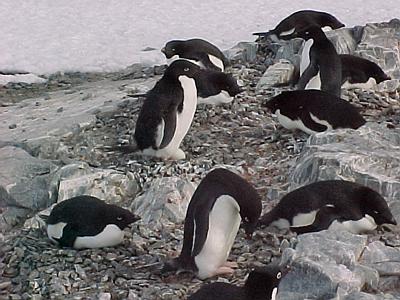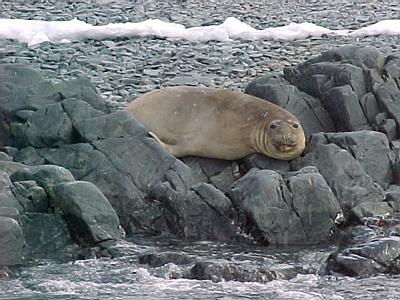27 November, 2000
Greetings,
Today we went out to deep water to conduct several casts. We went just past
station E. Station E is about 3 miles from Palmer Station, away from shore.
The water depth is between 150 - 165 meters. We selected this location
because we needed to make sure that when we sent our instrument package
down it wouldn't hit bottom. We would be conducting casts of 100 meters
(about 330 ft).
To get our instrument package down 100 meters we had to remove the floats
made from PVC pipe and attach new ones. The pressure would be so great at
those depths that there was a possibility that they could implode and
damage the equipment. We found a set of four flexible plastic flotation
devices that we attached. When the package descended the floats would
compress due to the pressure from the water. If you have ever been swimming
in three or four meters of water and feel the pressure against your ears,
you have some sense of how pressure affects objects. So our flotation
devices, blue buoys, had to be tied very securely to the package. Otherwise
at a depth of 100 meters the blue buoys would be much smaller in size and
come loose.
Our trip out to E was uneventful, although very cold. We conducted two CTD
(Conductivity, Temperature and Depth) casts to 100 meters. Then we sent our
package down to 100 meters four times. This was a three-person job. Ray
operated the sonar to check our depth, piloted the boat and guided the
winch so it wouldn't jam. Sarah and I traded jobs. We operated the winch;
raised and lowered the package over the side of the boat using a block and
tackle, powered the electronics before descent and guided the safety rope.
The safety rope was a new add-on to our device. The depth that we would be
taking our instruments would put a heavy strain on the winch and might
possibly break the winch line. So for safety reasons and cost of the
equipment we added the safety line. On the way down we had to keep it
taught so the line wouldn't get tied up around the ac9. On the way up we
had to help the winch raise the package. It was hard work.
We arrived back to Palmer around 1 PM. We cleaned our equipment and
downloaded our data. It will take several hours to determine if the data we
got today matches what we think it should look like. This was my
opportunity to run a set of chlorophylls while Sarah worked with the data
from the ac9. So, what do you think happens to the temperature of water as
you go deeper into the water column? What do you think happens to the
salinity (saltiness of water) of water with depth?
The answer to these questions and more tomorrow only at this web site. I
will also be joining Kirk, Sylvia and Wendy for core sampling day. Don't
miss it!
C-ya,
-- Bill

A group of Adelie's nesting.

An elephant seal.
Contact the TEA in the field at
.
If you cannot connect through your browser, copy the
TEA's e-mail address in the "To:" line of
your favorite e-mail package.
|
